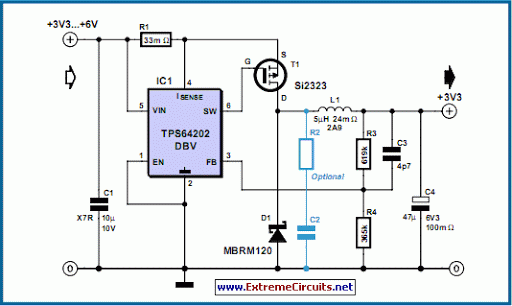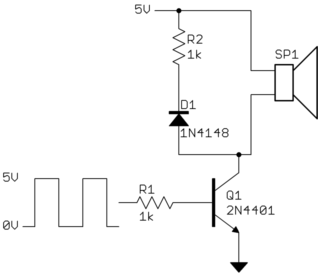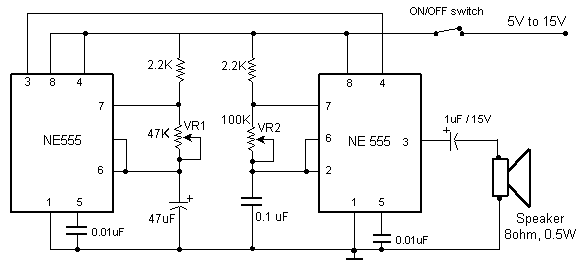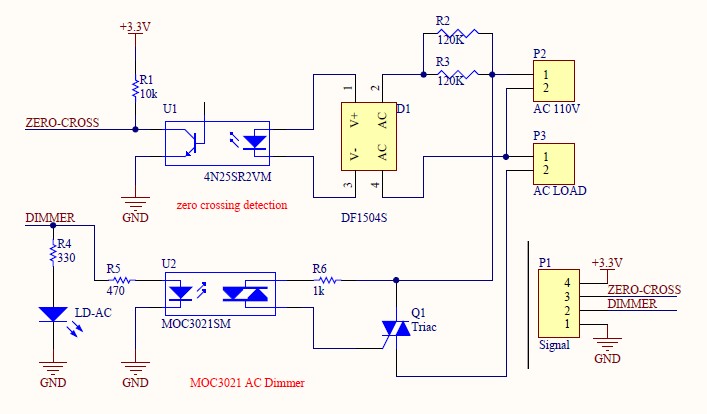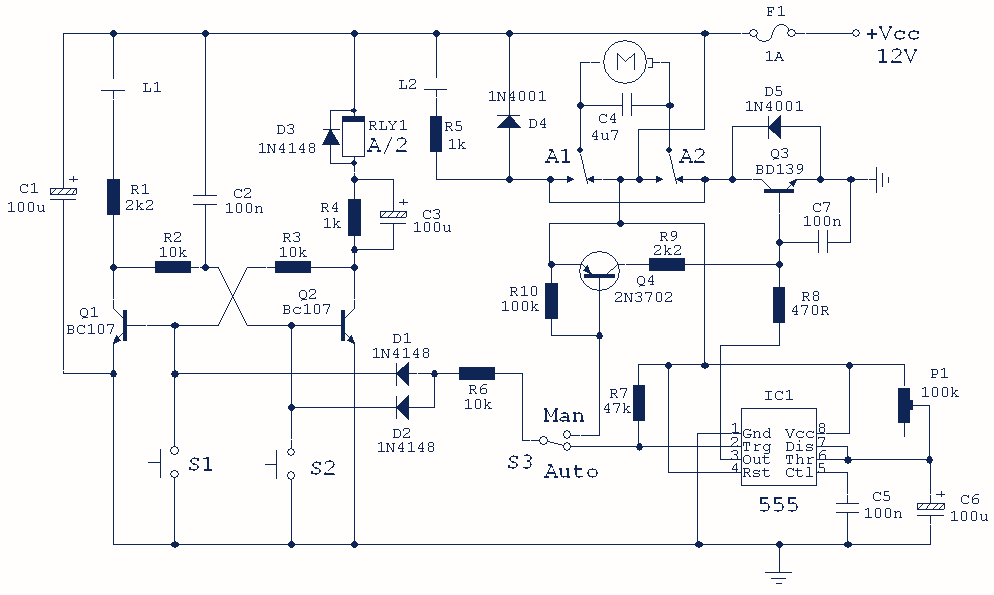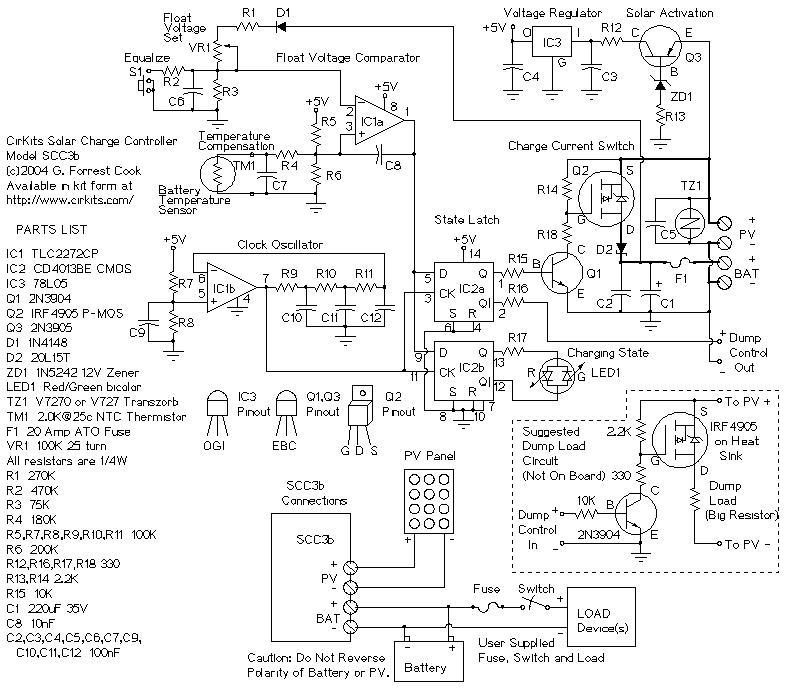
555 IC PWM Motor Control with Current Limiter
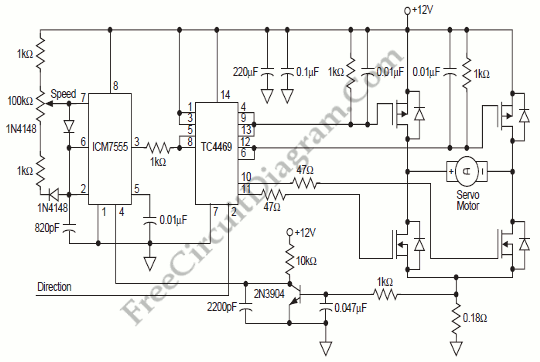
The circuit is designed to enable rapid changes in motor speed and direction by utilizing four outputs to drive a MOSFET H-bridge. The lower rail power MOSFETs are N-channel devices, while the upper rail MOSFETs are P-channel. All MOSFETs are controlled by the TC4469. A small series resistor is included to prevent gate oscillation and to slow down the transition time for the lower rail devices, ensuring that the upper device remains OFF. A resistor divider and a low-cost level shift transistor can be easily and economically incorporated to maintain a 15VDC gate drive for the upper rail MOSFETs when motor voltages exceed 12VDC. A simple linear regulator can be used to power the upper MOSFETs from the positive motor supply when it is above 15VDC, as the ICM7555 and TC4469 consume minimal current. To protect the gates from supply transients, Zener diodes can be utilized. When the lower MOSFET in the same leg is activated, resulting in a high dV/dT, gate-to-source capacitors assist in keeping the upper MOSFETs OFF. Additionally, maintaining low gate drive impedance for the upper MOSFETs in the OFF state is beneficial. A sense resistor placed in the ground leg of the H-bridge allows for pulse-by-pulse motor current sensing, regardless of the motor's forward or reverse rotation. This current signal is filtered and sent to the ICM7555 to inhibit PWM generation if the motor current exceeds the permissible limit.
The described circuit employs a MOSFET H-bridge configuration, which is essential for controlling the speed and direction of DC motors efficiently. The use of N-channel MOSFETs for the lower rail is advantageous due to their lower on-resistance compared to P-channel devices, resulting in reduced power losses and improved thermal performance. Conversely, P-channel MOSFETs are employed for the upper rail to facilitate high-side switching, which is crucial for maintaining the desired motor operation.
The TC4469 driver is integral to this design, as it provides the necessary gate drive signals to the MOSFETs, ensuring rapid switching and efficient control. The inclusion of a series resistor mitigates potential oscillations in the gate signal, which can lead to undesired switching behavior and increased electromagnetic interference (EMI). The transition time management is particularly important in applications requiring precise motor control.
For applications where motor voltages exceed 12VDC, the addition of a resistor divider and a level-shifting transistor allows for a stable 15VDC gate drive. This ensures that the upper rail MOSFETs are adequately turned ON to handle higher voltages without risking damage. The use of a linear regulator to derive the gate drive voltage from the motor supply is a practical solution, given the low current requirements of the driver ICs.
Zener diodes are recommended for gate protection against transient voltage spikes, which can occur during motor operation. These diodes clamp the voltage to safe levels, thus preserving the integrity of the MOSFET gates. The gate-to-source capacitors play a pivotal role in maintaining the OFF state of the upper MOSFETs during rapid changes in the lower MOSFET state, effectively preventing unwanted turn-on due to high dV/dT conditions.
Current sensing is facilitated by a sense resistor in the ground leg of the H-bridge, enabling real-time monitoring of motor current. This feature is crucial for implementing current limiting strategies, ensuring that the motor operates within safe parameters. The filtered current signal can be used to disable PWM generation when excessive current is detected, thus protecting the motor and the driver circuit from potential damage. Overall, this H-bridge design provides a robust solution for dynamic motor control applications.To provide rapid motor speed changes and motor direction reversal, four outputs drive a MOSFET H-bridge. N-channel devices are the lower rail power MOSFETs and P-channels are the upper MOSFETs. All of them are driven by the TC4469. A small series resistor helps prevent gate oscillation and slows transition time in the lower rail devices, helping t
he upper device to stay OFF. A resistor divider and low-cost level shift transistor can be added easily and economically to maintain a 15VDC gate drive for the upper rail MOSFETs for motor voltages over 12VDC. A simple linear regulator can power them from the positive motor supply when it is above 15VDC since the ICM7555 and TC4469 need negligible current.
To help protect the gates from supply transients, we can use a Zener diodes. When the lower MOSFET in the same leg turns ON , causing a high dV/dT, gate-to-source capacitors help keep the upper MOSFETs OFF . The other way to help that situation is keeping the upper MOSFET gate drive impedance low in the OFF state.
An easy way to sense motor current, pulse by pulse, regardless of forward or reverse motor rotation is provided by a sense resistor in the ground leg of the H-bridge. To inhibit PWM generation if motor current exceeds the allowed value, this signal is filtered and applied to the ICM7555.
[Microchip Application Notes] 🔗 External reference
The described circuit employs a MOSFET H-bridge configuration, which is essential for controlling the speed and direction of DC motors efficiently. The use of N-channel MOSFETs for the lower rail is advantageous due to their lower on-resistance compared to P-channel devices, resulting in reduced power losses and improved thermal performance. Conversely, P-channel MOSFETs are employed for the upper rail to facilitate high-side switching, which is crucial for maintaining the desired motor operation.
The TC4469 driver is integral to this design, as it provides the necessary gate drive signals to the MOSFETs, ensuring rapid switching and efficient control. The inclusion of a series resistor mitigates potential oscillations in the gate signal, which can lead to undesired switching behavior and increased electromagnetic interference (EMI). The transition time management is particularly important in applications requiring precise motor control.
For applications where motor voltages exceed 12VDC, the addition of a resistor divider and a level-shifting transistor allows for a stable 15VDC gate drive. This ensures that the upper rail MOSFETs are adequately turned ON to handle higher voltages without risking damage. The use of a linear regulator to derive the gate drive voltage from the motor supply is a practical solution, given the low current requirements of the driver ICs.
Zener diodes are recommended for gate protection against transient voltage spikes, which can occur during motor operation. These diodes clamp the voltage to safe levels, thus preserving the integrity of the MOSFET gates. The gate-to-source capacitors play a pivotal role in maintaining the OFF state of the upper MOSFETs during rapid changes in the lower MOSFET state, effectively preventing unwanted turn-on due to high dV/dT conditions.
Current sensing is facilitated by a sense resistor in the ground leg of the H-bridge, enabling real-time monitoring of motor current. This feature is crucial for implementing current limiting strategies, ensuring that the motor operates within safe parameters. The filtered current signal can be used to disable PWM generation when excessive current is detected, thus protecting the motor and the driver circuit from potential damage. Overall, this H-bridge design provides a robust solution for dynamic motor control applications.To provide rapid motor speed changes and motor direction reversal, four outputs drive a MOSFET H-bridge. N-channel devices are the lower rail power MOSFETs and P-channels are the upper MOSFETs. All of them are driven by the TC4469. A small series resistor helps prevent gate oscillation and slows transition time in the lower rail devices, helping t
he upper device to stay OFF. A resistor divider and low-cost level shift transistor can be added easily and economically to maintain a 15VDC gate drive for the upper rail MOSFETs for motor voltages over 12VDC. A simple linear regulator can power them from the positive motor supply when it is above 15VDC since the ICM7555 and TC4469 need negligible current.
To help protect the gates from supply transients, we can use a Zener diodes. When the lower MOSFET in the same leg turns ON , causing a high dV/dT, gate-to-source capacitors help keep the upper MOSFETs OFF . The other way to help that situation is keeping the upper MOSFET gate drive impedance low in the OFF state.
An easy way to sense motor current, pulse by pulse, regardless of forward or reverse motor rotation is provided by a sense resistor in the ground leg of the H-bridge. To inhibit PWM generation if motor current exceeds the allowed value, this signal is filtered and applied to the ICM7555.
[Microchip Application Notes] 🔗 External reference
Warning: include(partials/cookie-banner.php): Failed to open stream: Permission denied in /var/www/html/nextgr/view-circuit.php on line 713
Warning: include(): Failed opening 'partials/cookie-banner.php' for inclusion (include_path='.:/usr/share/php') in /var/www/html/nextgr/view-circuit.php on line 713
